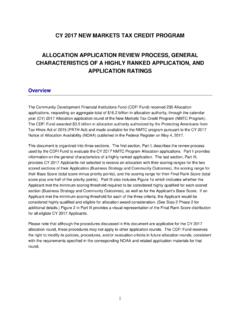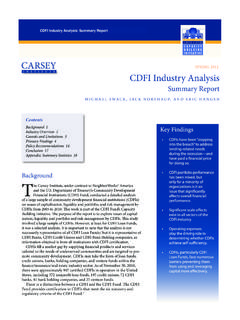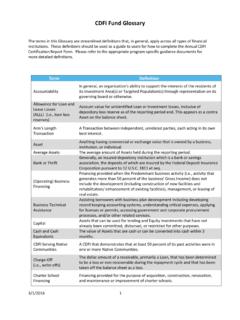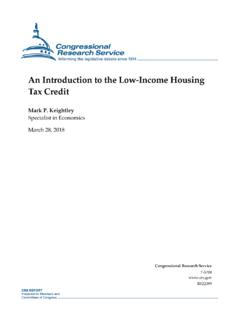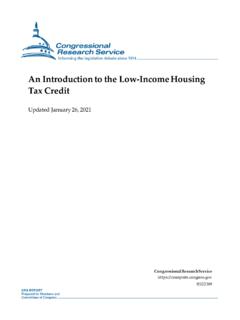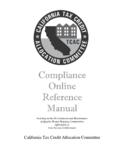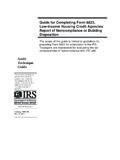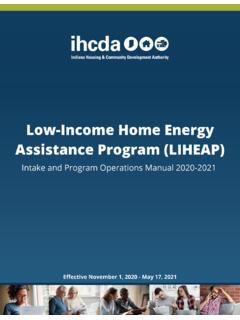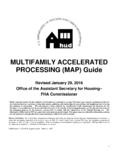Transcription of 2020 Introduction to the New Markets Tax Credit Program
1 Introduction to the New Markets Tax Credit ProgramPREPARED ONSeptember 15, 2020 The CDFI Fund is an equal opportunity provider. Overview of CDFI Fund Programs & Initiatives NMTC Program Key Terms NMTC Program History and Overview CDEC ertification How can NMTCs work for your organization? Information on Prior NMTC AllocationsPresentation Roadmap9/15/2020// 2 Created in 1994 Mission: To expand economic opportunity for underserved people and communities by supporting the growth and capacity of a national network of community development lenders, investors, and financial service providers. Vision: An America in which all people and communities have access to the investment capital and financial services they need to Fund Overview9/15/2020// 3 The CDFI Fund achieves its mission by directly investing in and supporting Community Development Financial Institutions(CDFIs), Community Development Entities (CDEs), and other financial institutions through the following programs and initiatives.
2 Bank Enterprise Award (BEA) Program CDFI Bond Guarantee Program Capital Magnet Fund (CMF) CDFI Program (FA & TA) Native Initiatives (NACA) New Markets Tax Credit (NMTC) ProgramCDFI Fund Overview9/15/2020// 4 Low-Income Community (LIC) Community Development Entity (CDE) Qualified Equity Investment (QEI) Qualified Low-Income Community Investment (QLICI) Qualified Active Low-Income Community Business (QALICB) Financial Counseling and Other Services (FCOS)NMTC Program Key Terms9/15/2020// 5 The NMTC Program was authorized under the Community Renewal and Tax Relief Act of 2000, and has been subject to reauthorization since 2006. Most recently, the Taxpayer Certainty and Disaster Tax Relief Act of 2019 provided $5 billion in NMTC Allocation authority for calendar year 2020. In the 16application rounds to date, the CDFI Fund has made 1,254 allocation awards totaling $61 billion in tax Credit authority.
3 Includes $3 billion in Recovery Act awards and $1 billion for recovery and redevelopment from Hurricane Program History9/15/2020// 6 The NMTC Program is jointly administered by the CDFI Fund and the Internal Revenue Service (IRS). Investments made through the NMTC Program must comply with regulations outlined in Section 45D of the Internal Revenue Code. NMTC Program Overview9/15/2020// 7 NMTCs provide a Credit against Federal income taxes for investors that make Qualified Equity Investments (QEIs) in certified financial intermediaries called Community Development Entities (CDEs). NMTCs are awarded to CDEs, notto individuals or businesses. CDEs, in turn, use the proceeds of these QEIsto make Qualified Low-Income Community Investments (QLICIs), such as business loans, in Low-Income Communities. NMTC Program Overview9/15/2020// 8 The New Markets Tax Credit is taken over a 7-year period.
4 The Credit rate is: 5% of the original investment amount in each of the first three years; and 6% of the original investment amount in each of the final four years. Total Credit equals 39% of the original amount invested in the CDE. Tax Credit AmountYear 1 Year 2 Year 3 Year 4 Year 5 Year6 Year 7 TOTAL5%5%5%6%6%6%6%39%9/15/2020// 9 The CDFI Fund awards a tax Credit allocation of $1 million to a CDE. The CDEoffers the tax Credit to a single investor in exchange for a $1 million equity investment. Generates a $50,000 Credit annually for the first three years; Generates a $60,000 Credit annually for the final four years. Total Credit value over 7 years is $390, Credit Amount -ExampleYear 1 Year 2 Year 3 Year 4 Year 5 Year6 Year 7 TOTAL$50,000$50,000$50,000$60,000$60,000 $60,000$60,000$390,0009/15/2020// 10 NMTCs may be recaptured from investors during the 7-year Credit period under certain circumstances.
5 Events triggering recapture include: The QEIfails the substantially-all requirement. Failure to invest 85% of original QEI; or Failure to meet Qualified Active Low-Income Business (QALICB) requirements; or Failure to meet one-year investment/ reinvestment requirement The CDEredeems the investment. The CDEceases to qualify as a CDE.*It is not an event of recapture if a CDE files for bankruptcy. An investor may continue to claim NMTCs. Tax Credit Recapture9/15/2020// 11 The CDFI Fund awards a proportional amount of tax credits for investing in Non-Metropolitan Counties. The number of Rural CDEs in the Awardee pool are proportional to the number of Rural CDEs that meet minimum scoring thresholds. A goal to invest 20% of QLICI smade using QEIproceeds into Non-Metropolitan Counties. To be a Rural CDE, an organization must: Have a track record of at least 3 years of direct financing experience; Have dedicated at least 50% of its direct financing activities in the last 5 years to Non-Metropolitan Counties; and Commit that at least 50% of QLICI swill be directed to Non-Metropolitan Counties9/15/2020// 12 The NMTC Program provides an incentive for investment in Low-Income Communities (LICs).
6 LICsare census tracts: Where the poverty rate is at least 20%; or Where the median family income does not exceed 80% of the area median family income; or Where the median family income does not exceed 85% of the area median family income provided the census tract is located in a high migration rural county; or Where the census tract has a population of less than 2,000 and is contained within a Federally designated Empowerment Zone and is contiguous to at least one other LIC. What is a Low-Income Community?9/15/2020// 13 Businesses not located in LICsbut that otherwise serve Targeted Populations may also qualify for NMTC-enhanced loans/investment. Targeted Populations include: Low-Income Persons ( family income no greater than 80% of the applicable area median family income), to the extent the project is located in a census tract with a median family income at or below 120% of the median family income.
7 Refer to IRS and CDFI Fund guidance for additional details. Low-Income Communities Targeted Populations9/15/2020// 14 The CDFI Fund offers tools and guidance on determining whether a business is located in an LIC. CDFI Information Mapping System (CIMS) indicates whether a census tract qualifies as an LIC Additional information and guidance is also available at Program Eligibility Guidance .Finding a Low-Income Community9/15/2020// 15 A Community Development Entity (CDE) is a domestic corporation or partnership that is an intermediary vehicle for the provision of loans, investments, or financial counseling in Low-Income Communities. To qualify as aCDE, a domestic corporation or partnership must apply for and receive certification from the CDFI Fund. What is a CDE?9/15/2020// 16 CDEsor organizations with a pending CDEcertification Application are eligible to apply for an NMTC allocation.
8 To be awarded an allocation of NMTCs, CDEs must apply through a competitive application process administered by the CDFI Fund. Only a certified CDE that has been awarded an allocation of NMTCs can offer NMTCs for sale to investors. If awarded an NMTC allocation, CDEsmust issue QEIswithin 5 yearsof receiving an allocation. Only CDEs Can Apply for an NMTC Allocation9/15/2020// 17 In order to claim the NMTCs, an investor must make an equity investment into a CDE provide cash for either stock in a corporation or a capital interest in a partnership in exchange for the credits. The equity investment must be acquired by the investor at its original issue, solely in exchange for cash. The equity investment must be designated by the CDEas a Qualified Equity Investment (QEI). The QEImust remain invested in the CDEduring the 7-year tax Credit period from the date the investment was initially made.
9 Qualified Equity Investment (QEI)9/15/2020// 18 Substantially all of QEIproceeds must be invested in Qualified Low-Income Community Investments (QLICIs) within 12 months: Years 1 6:Substantially All = 85% of amount paid by investor at original issue. Generally, returns of equity, capital or principal must be reinvested within 12 months. Year 7:Substantially All = 75%. Reinvestment is not required in the final year of the 7-year Credit period. Use of QEI Proceeds9/15/2020// 19 QLICI sinclude: Any capital or equity investment in, or loan to, a Qualified Active Low-Income Community Business (QALICB). Purchase of a loan from another CDEif the loan is a QLICI. Any equity investment in, or loan to, a CDE. Financial Counseling and Other Services (FCOS) to businesses located in, or residents of, Low-Income Communities(LICs). Qualified Low-Income Community Investments (QLICIs)9/15/2020// 20 AQALICB must meet these requirements: At least 50% of the total gross income is from the active conduct of a qualified business in Low-Income Communities(LICs); and At least 40% of the use of tangible property of the business is within LICs; and At least 40% of the services preformed by the business employees are performed in LICs; and Less than 5% of the average of the aggregate unadjusted basis of the property is attributable to collectibles( art and antiques), other than those held for sale in the ordinary course of business; and Less than 5% of the average of the aggregate unadjusted basis of the property is attributable to non-qualified financial property ( debt instruments with a term in excess of 18 months).
10 Qualified Active Low-Income Community Business (QALICB)9/15/2020// 21 An operating business ( manufacturer, grocery store) located in a Low-Income Community(LIC). A business that develops or rehabilitates commercial, industrial, retail, and mixed-use real estate projects in an LIC. A business that develops or rehabilitates community facilities, such as charter schools or health care centers, in an LIC. A business that develops or rehabilitates for-sale housing units located in LICs. Examples of QALICBs9/15/2020// 22 CDEsmay purchase loans, but notinvestments, from other CDEsif: The purchased loans were originated by an entity that was a CDEat the time the loan was sold; and The loans qualified as QLICIs at either the time the loan was: Originated, or Purchased by the AllocateeCDE. Purchasing Loans from Other CDEs9/15/2020// 23 Investment may be made through multiple layers of CDEs( up to 4 CDEs).


